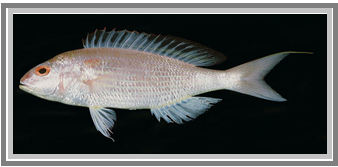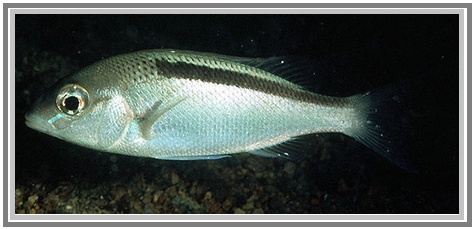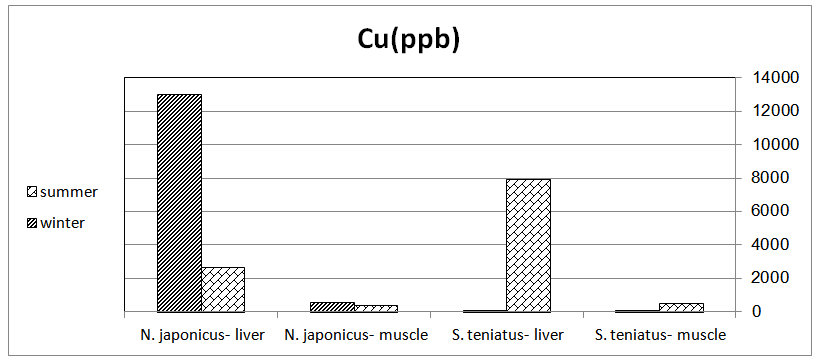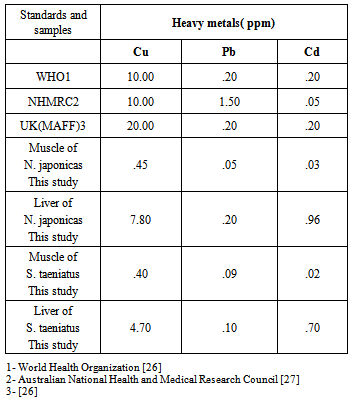-
Paper Information
- Previous Paper
- Paper Submission
-
Journal Information
- About This Journal
- Editorial Board
- Current Issue
- Archive
- Author Guidelines
- Contact Us
Marine Science
p-ISSN: 2163-2421 e-ISSN: 2163-243X
2014; 4(2): 38-43
doi:10.5923/j.ms.20140402.02
Variation of Heavy Metal Concentration (Cu, Pb and Cd) in Nemipterusjaponicus (Bloch, 1793) and Scolopsistaeniatus (Cuvier, 1830) in Hot and Cold Season in the Coastal Waters of Bushehr Province (Persian Gulf-Iran)
Nejatkhah Manavi P.1, Zardoost S.1, Vosoughi A.2
1Marine Biology Dept., Faculty of marine science and Technology, Islamic Azad University, North Tehran branch, Iran
2Fisheries Dept., Faculty of marine science and Technology, Islamic Azad University, North Tehran branch, Iran
Correspondence to: Nejatkhah Manavi P., Marine Biology Dept., Faculty of marine science and Technology, Islamic Azad University, North Tehran branch, Iran.
| Email: |  |
Copyright © 2014 Scientific & Academic Publishing. All Rights Reserved.
Concentrations of heavy metals ( Cu, Pb and Cd) in muscle and liver of two fish species Nemipterusjaponicus and Scolopsistaeniatus (Nemipteridae) been studied in Bushehr waters (ports: Dayer and Assaluyeh) in winter 2011 and summer 2012. Fish samples collected from local trawler men, three replicate of each samples were analyzed using wet method (ASTM, 1999) in which 0.5 gr from each sample (liver and muscle tissues) were digested and analyzed by atomic absorption spectroscopy (AAS- graphite furnace). Concentration of copper (7225.5±1244 ppb) in liver was highest in winter time comparing to plumb (213.5±127.65 ppb) and cadmium (925.5±106.85 ppb). Concentrations difference of heavy metals in fish tissues was statistically significant between the two seasons (P≤0.05). Highest concentrations of Pb (213.5±127.65 ppb), Cd (925.5±106.85 ppb) and Cu (7225.5±1244 ppb) were measured in liver tissues while lowest concentrations of Pb (49±0 ppb), Cd (34.16±3.77 ppb) and Cu (445.85±70.7 ppb) been seen in muscle tissues. Using one way analysis, concentrations of all three heavy metals in muscles, mostly shows significant differences between the two seasons (P<0.05). Generally, mean concentrations of all heavy metals were higher in winter than in summer time. Mean concentration of Cd (925.5±106.85 ppb) in liver tissues was higher than recommended standards by NHMRC (0.05µg/g), WHO (0.02µg/g) and MAFF (0.02µg/g) while for Cu and Pb it was lower than standards in both liver and muscle tissues.
Keywords: Heavy Metals, Nemipterusjaponicus, Scolopsistaeniatus, Bushehrwaters, Persian Gulf
Cite this paper: Nejatkhah Manavi P., Zardoost S., Vosoughi A., Variation of Heavy Metal Concentration (Cu, Pb and Cd) in Nemipterusjaponicus (Bloch, 1793) and Scolopsistaeniatus (Cuvier, 1830) in Hot and Cold Season in the Coastal Waters of Bushehr Province (Persian Gulf-Iran), Marine Science, Vol. 4 No. 2, 2014, pp. 38-43. doi: 10.5923/j.ms.20140402.02.
Article Outline
1. Introduction
- Persian Gulf with 240,000 Km2 which been stretched along the Oman Sea and located between Arabian Peninsula and Iran connects to the Oman Sea and Indian Ocean via Strait of Hormuz. With 40 meter as an average depth and the water retention time of 3-5 hour, the potential retain of pollutant is high in this water body [1]. Persian Gulf with high diversity in its aquatic organisms is considered one of the most valuable aquatic ecosystems in the world [2]. Increases of population, city expansions, industrial developments, unsustainable uses of natural resources and so on are considered the main pollution factors in this area. Pollution of aquatic organisms is of great important here, as heavy metals which are considered stable pollutants don’t decompose in environment through the chemical or biological processes. Study shows that heavy metal pollutions could have ecological no equilibrium effects on any receiving environment by reducing the diversity of aquatic organisms and particularly fishes [3,4]. These pollutants could enter food chain through different biochemical process like bio concentration, bioaccumulation and finally bio magnifications and threaten human health after consumption of sea foods [5]. In recent years, increases in aquatic foods demand especially fishes as an important source of protein due to population growth from one side and reduces in some of commercial fish stock resources due to stock depletion from other side, forciblyincreases the consumption of less important fishes like Nemipteridae family which used to be discarded before this as by catch [6]. In 1982, concentrations of heavy metals were studied by Persian Gulf country members in ROPME sea area. Changing trend of heavy metals in Nemipteridae family in Persian Gulf and other parts of the world were also studied by some researchers. Concentrations of arsenic and mercury in 2010 and concentrations of copper, plumb, cadmium and zinc in 2011 were studied for Nemipterusjaponicus in Persian Gulf [7]. Effects of Ni, Co, Fe, Pb, Cd, Zn and Cu on Nemipteridaein Kochi and Mangalore areas in southwest of India were studied [8]. Effects of Cd, Zn, Cu and Pb were studied on N. japonicus in Cochin at southwest coast of India [9]. Concentrations of Hg, As and Zn were measured in Nemipterusjaponicas and four different fish species in southwest coast of Malaysia [5]. Amounts of Fe, Cu, Pb, Cr, Co and Mn were studied in N. japonicus and some other fish species of Red Sea [10].Concentration of Hgin N. japonicus and other fish species were studied in coastal waters of Madras in India [11]. As no study on concentrations of heavy metals in Nemipteridae fishes in Bushehr waters been reported yet, the amounts of these elements in both liver and muscle tissues were studied as people use fish muscles as food and fish liver has an important role of metabolism and detoxification [12].Therefore, to make sure that their consumption is safe, concentrations of Cd, Pb and Cu in muscle and liver tissues of N. japonicus and S. taeniatus were measured and compared to current international standards during winter and summertime in Bushehr waters.
2. Material and Methods
- Fish samples in three replicates were taken from trawler men in port Dayer and Assaluyehin Bushehr waters (Figs.1-A & 1B) and only two species of N. japonicus and S. taeniatus from Nemipteridae family were found in the two areas (Figs.2 & 3).
 | Figure 1. Sampling area (A. Port Assaluyeh; B. Port Dayer) in coastal waters of Bushehr province, Persian Gulf |
 | Figure 2. Nemipterusjaponicas |
 | Figure 3. Scolopsistaeniatus |
3. Fish Tissues Preparation and Digestion Method
- Muscle and liver tissues were digested using wet method after thawing in which 0.5 gr from each sample (liver and muscle tissues) were digested in nitric acid and diluted to 25 ml adding distilled water. Concentrations of Cd, Pb and Cu in digested solution were measured [13] using atomic absorption spectroscopy with graphite furnace AAS-Furnace (Perkin Elmer company, model: 4100). One-way Analysis of variance (ANOVA) were performed using "Minitab" and "Origin" programs. Concentrations of heavy metals and their descriptive information were shown using tables and draws and their correlations were determined using Pearson`s correlation formula (r).
4. Results
- Concentrations of Cu and Cd was higher in winter time except for Pb (winter: 142±19.3 ppb; summer: 285±236 ppb). Generally, amounts of heavy metals in liver were higher than muscle tissues. Concentrations of Cu in muscle and liver tissues were highest (3347.46 ppb) for both fishes N. japonicus and S. taeniatus in compare to Cd and Pb with concentrations of 425.82 and 130.87 ppb respectively.In both species, mean concentration of Cu in liver was higher than muscle tissues (Fig.4).Concentration of Pb in liver tissues was lower than its maximum allowable concentration (300 ppb) for muscle tissues (Fig.5).After Cu (7225±1244 ppb) Cd shows the highest concentration (925.5±106 ppb) in liver tissues of both species and the same as Cu its concentration was higher in liver than muscle (Fig.6). Concentrations of Cu was significantly difference (P<0.05) between muscle and liver tissues in S.taeniatus during summer (one-way ANOVA). In N.japonicus, concentrations of Cd shows significant differences (P= 0.002) between tissues and also seasons (p<0.05) while it was not seen for other two elements [(P>0.05) (Fig.6)]. For instance, no significant differences (P>0.05) were observed for concentration of Cu in muscle tissues between the two seasons in N. japonicus (P= 0.193). Pearson test didn’t show any correlations for concentrations of heavy metals in muscle and liver tissues with seasons (Pearson test is a measure of the linear correlation between two variables; giving a value between +1 and −1 where 1 is total positive correlation 0 is no correlation, and −1 is negative correlation).There was a correlation (r=1) and also significant difference (P<0.05) between concentrations of Pb and two other elements (Cu and Cd) in muscle tissues of S.taeniatus in both seasons.
 | Figure 4. Mean concentrations of Cu in Nemipetidae fishes during winter 2011 and summer 2012 in coastal waters of Bushehr province |
 | Figure 5. Mean concentrations of Pb in Nemipetidae fishes during winter 2011 and summer 2012 in coastal waters of Bushehr province |
 | Figure 6. Mean concentrations of Cd in Nemipetidae fishes during winter 2011 and summer 2012 in coastal waters of Bushehr province |
5. Discussion and Conclusions
- Based on the results, mean concentrations of Cu, Pb and Cd in liver tissues (2417.27±362.22 ppb) of N. japonicus and S. taeniatuswas higher than it in muscle tissues (176.89±32.76). Higher amounts of these elements in liver could be due to high activity in this organ for storing elements and catalysers. Different organs in organisms get their necessary elements and catalyser from liver [14]. Therefore, this organ could be an efficient biomarker for possible contamination of waters by heavy metals [15]. Differences in amounts of heavy metals in different fish organs could be due to differences in ability of these elements in breaking of existed metal protein bonds like in Metallothionein. Differences in metabolic activities and ecological needs could be also among some other factors [16]. Heavy metals choose their target organ based on degree of metabolic activities in that specific organ which would explain the main reason for higher accumulation of these elements in liver, kidney and gills in compare to muscles [17].In this study, for both fish species and seasons concentrations of heavy metals were, in descending order: Cu>Pb> Cd. In both seasons of winter and summer, concentration of Cu in muscle and liver tissues of both species (3347.46 ± 478.67 ppb) was higher than Cd (425.82 ± 63.34 ppb) and Pb (118.33 ± 50.46 ppb). In fishes, generally, essential heavy metals like Cu, Co, Zn and so on bioaccumulate normally in higher concentrations in compare to unessential toxic heavy metals such as Pb, Cd and Hg. Mean concentration of Cu in liver tissues (13037± 2298 ppb) during winter was higher than it (2658 ± 190 ppb) in summer time (Fig.5). Different factors like water temperature, precipitation potential, food regimen, breeding and growth patterns could change concentration of heavy metals in fish tissues. Concentrations of different elements like heavy metals usually increases in aquatic ecosystems through watershed runoff after raining season which supports our findings in this study. Our findings are also compatible with the results presented by Kamaruzzaman [5] for study on five fishes: Nemipterusjaponicas, Lutijanussebae, Pampusargenteus, Otolithusruber and Chirocentrusdorab in southwest coasts of Malaysia. In a separate study in Persian Gulf, concentrations of Cd, Pb, Cu and Zn in muscle tissues of some pelagic (Chirocentrusdorab, Sphyraenajello and Thunustonggol) and demersal fishes (Platycephalusindicus, Nemipterusjaponicus and Epinepheluscoioides) during winter time shows seasonal fluctuations in concentration of heavy metals with highest amounts of Cd, Pb, Zn and Cu for demersal fishes in winter season [7]. In a different study, concentrations of As, Cu, Zn, Cd and Pb in two fish species: Soleasenegalensis and Sparusaurata from rivers Tinto and Odiel in Spain show that concentration of Cu and Zn in liver tissues of both fishes was highest [18]. Findings by Mondol [19] were also supports our results in this study.Studies show that there is a correlation between concentration of heavy metals and their exposing time with their bioaccumulation in fish tissues in aquatic environment [20,21]. In aquatic organisms, their methods of acquiring foods from the surrounding environments could be of great importance in bioaccumulation of heavy metals in their tissues and in fishes it happens mostly through eating and, to lesser amount, through direct absorption from water column [8]. Sex and size are also among those factors that affects bioaccumulation of heavy metals in tissues of different fishes [20, 21). In a study on different fish species such as Nemipterusjaponicus, Latescalcarifer, Caranxmelampygus, . Rastrelligerkanagurta and Cyanoglossusmacrostomus in southwest coasts of India, concentrations of Ni, Cu, Cd and Fe was high in demersal fishes like Nemipterusjaponicus and Caranxmelampygus while in pelagic fishes like Latescalcarifer concentrations of Pb, Zn and Co was highest [22]. They unanimously mentioned in their studies that, concentrations of heavy metals are higher in demersal species in compare to pelagic species which could be due to their higher contanct with bottom sediments. The findings of the current study are in consistent with aforementioned studies, as concentrations of Cu and Cd in both Nemiperidae fishes (demersal fishes) were higher in compare to Pb. Lead is considered a toxic and bioaccumulative element which able to enter blood circulating system, central nervous system, liver and kidneys after bonding to SH proteins in body [9]. The same as Cu and Cd, concentrations of Pb in liver tissues of both fish species was higher than it in muscle tissues. In Bandar Abbas city, mean concentration of Pb in liver tissues of parastromateusniger was higher in compare to muscle tissues [23]. Concentrations of Pb in muscle tissues of S.taeniatus shows significant difference [(P < 0.05), (P = 0.002 & P = 0.018)], in compare to Cu and Cd in summer season, though, the amount was lower than the value of maximum standard (300 ppb) in fish muscle (Fig 6).In this study, concentration of Cd in liver tissues of N.japonicus was highest (1552 ppb) which put it in second rank after Cu which shows highest concentrations in liver tissues in both species (Fig.6). In N.japonicus, concentrations of Cd in muscle tissues show significant seasonal differences (P < 0.05). Different studies were also showing the same seasonal variations for amounts of heavy metals in fish tissues [24, 25]. In current study, concentrations of Cd in liver tissues of both species was higher than the set international standards for concentration of Cd in liver tissues, though, its amounts in muscle tissues, which is the most consumable part, was lower than the set standard value. In both fish species, even though the concentration of the two other metal elements (Pb and Cu) in liver tissues was higher than it in muscle tissues, but their mean concentrations didn’t exceed the allowable standard value (Table 1).
|
 Abstract
Abstract Reference
Reference Full-Text PDF
Full-Text PDF Full-text HTML
Full-text HTML